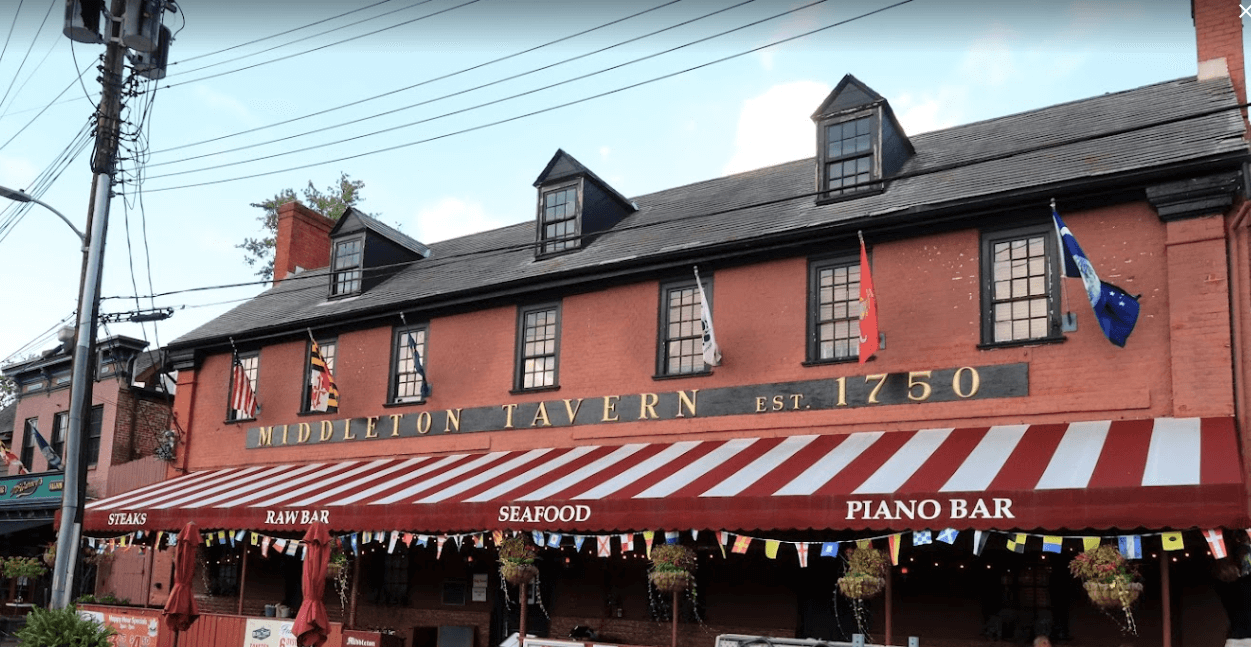
At Annapolis’s historic Middletown Tavern, spirits aren’t just something to be drunk, but rather, seen. Constructed in 1740 as a private residence, this Georgian-style building became the lodge and drinking establishment it’s known for being today when its original owner, Elizabeth Bennett, sold her home to ferry operator Horatio Middletown in 1750. Sensing a demand for lodging for his customers, Middleton quickly turned the building into an inn.
Over time, the tavern became a popular spot for the townspeople to concrete, socialize, and drink together, and it was even a favored meeting place for Freemasons and esteemed groups like the Maryland Jockey Club. After Middleton died, his wife and son continued to run the tavern in addition to his ferry business. Throughout the years, several prominent figures of the American Revolution stayed at the inn during their travels, meaning there’s a lot of history—and perhaps, strange spirits from the past—still present in the building today.
Although no major battles took place in Maryland, the city of Annapolis has a particularly special connection to the American Revolutionary War, as it once briefly served as the capital of the confederation government from November 26, 1783, to June 3, 1784. It was also in Annapolis where General George Washington famously resigned as Commander in Chief of the Continental Army in 1783, and where the Treaty of Paris was finally signed in the Old Senate Chamber of the Maryland State House in 1784.
It’s estimated that over 25,000 American soldiers lost their lives during active military service, or shortly after due to disease. And even though Annapolis might’ve not been at the center of any conflict, the repercussions of the war were certainly felt by residents across town. With the bodies of tens of thousands of men now buried deep in the ground, tensions rose between Loyalists and Patriots, leading to a divided social structure that would lead to suffering, bitter arguments, and sinister rivalries even after the war had ended.
Thanks to Middletown Tavern’s proximity to the nearby harbor, Horatio Middletown was finding extreme financial success with both of his businesses: his tavern and his ferry rides. Although he didn’t live to see the height of the Revolutionary War, his bar would later become a crossroads for prominent political leaders traveling throughout the colonies, including George Washington, Thomas Jefferson, and Benjamin Franklin, all of which stayed at Middletown Tavern.
Tench Tilghman also stopped at Middletown Tavern on the way to Philadelphia with the message of Cornwallis’ surrender at Yorktown. The inn was also frequented by members of the Continental Congress and perhaps even by President James Monroe in 1818, shortly after his election to office.
During the war, the bar was operated by George Mann. And not only was it an easy place to stop for a quick drink or a warm bed, but it was an early showplace of Annapolis thanks to its sprawling gardens, which spread from Prince George Street to the water’s edge.
It’s long been said that several different spirits continue to haunt the Middleton Tavern from beyond the grave, terrifying both staff members and unsuspecting guests. Given that it’s a 250-year-old building, there’s bound to be a web of chilling mysteries and inexplicable manifestations hiding deep within the tavern’s walls.
One of these ghosts is the figure of a man who workers have named “Roland,” who roams the bar dressed in Revolutionary War-era clothing. The spirit has been seen looking pensively out of one of the dining room windows at the harbor, where Horatio’s ferries used to dock, perhaps searching for a lost loved one. Several unexplained shadowy figures also linger around the tavern, kicking around lanterns, tables, and chairs without any help from the living.
Today, the Middleton Tavern continues to operate as a full-service restaurant specializing in seafood like Maryland crab cakes, rockfish, oysters, and clams. While the inn itself has since been closed, diners are still encouraged to explore the historic building, which, according to the Middleton Tavern’s official website, features “Civil War muskets, old Naval Academy uniforms, nautical-themed pictures, and classic Maryland landscape paintings.”
Entertainment-wise, the restaurant is also well-known for its live music events, from piano to jazz, to acoustic blues. The tavern stands as a testament to the power of preserving our history, standing proudly in the center of Maryland’s capital city for over 250 years.
Middleton Tavern is the oldest, continually-operating bar in Maryland, meaning the preservation of this historic building is no small feat. For over 50 years, the tavern was owned by Jerry Hardesty, who purchased it from Cleo and Mary Apostol in 1968. Hardesty was responsible for restoring and completely renovating the building and switching the restaurant’s name back to the original Middleton Tavern after it was renamed the “Mandris Tavern” in the 1800s.
Significant updates, remodeling, and expansion on the structure took place in 1983, which opened up the tavern’s upstairs dining rooms to allow for more space. Hardesty passed away in 2021 at the age of 79. For more on the continued conservation of Middleton Tavern and other famously haunted eateries, check out our other blog posts, and come back for more information in future updates.
Sources Cited:
http://hauntedhouses.com/maryland/middleton-tavern/
https://www.middletontavern.com/
https://www.gpsmycity.com/attractions/middleton-tavern-49092.html
https://en.wikipedia.org/wiki/Maryland_in_the_American_Revolution